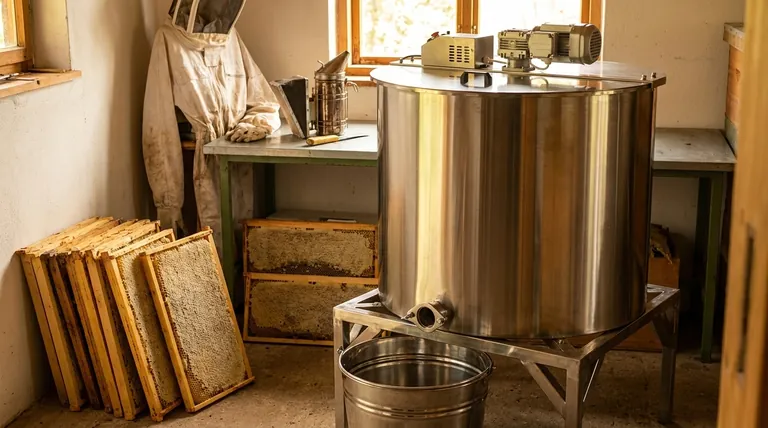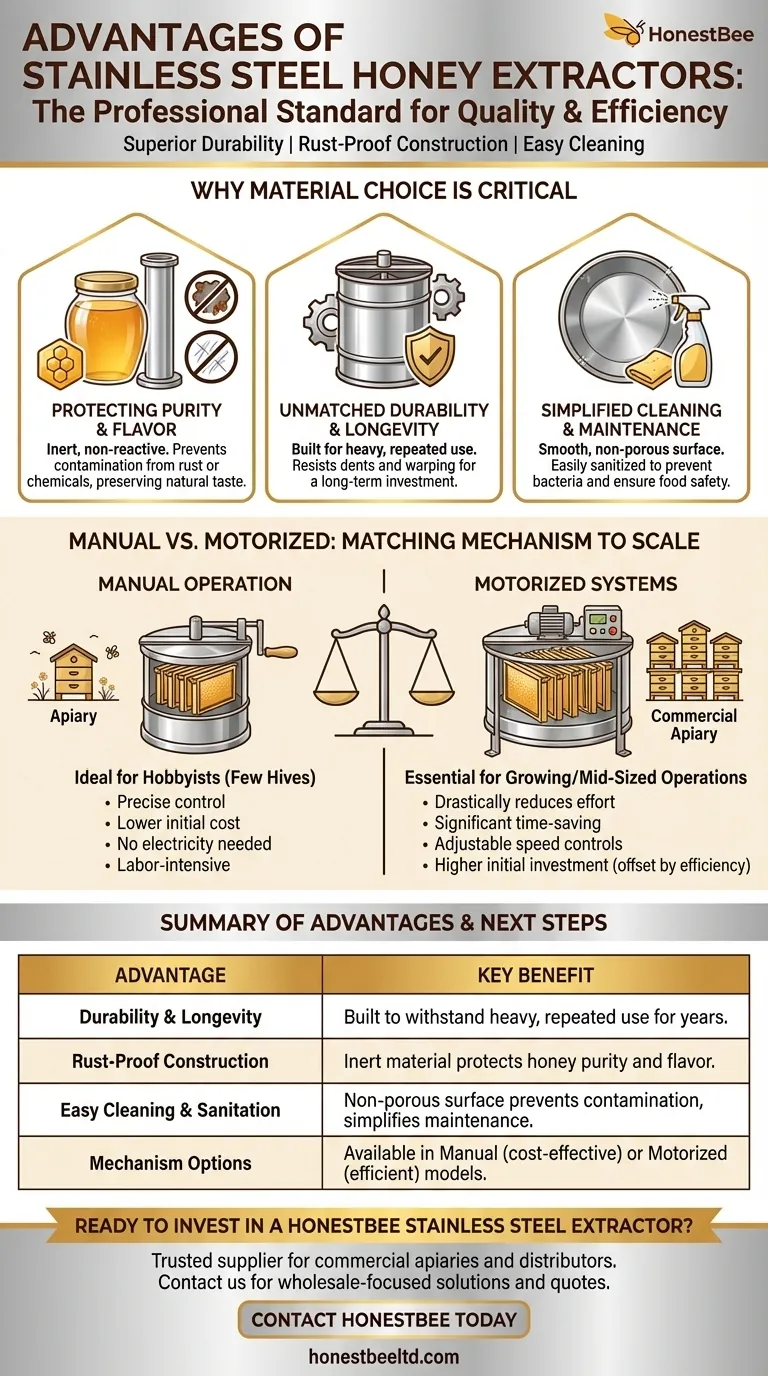In short, the primary advantages of stainless steel honey extractors are superior durability, rust-proof construction, and ease of cleaning. These characteristics make them the professional standard for ensuring honey purity and represent a reliable, long-term investment for any serious beekeeper. They are built to withstand heavy use and their non-porous surface prevents contamination, safeguarding the quality of your honey.
The decision to use a stainless steel extractor is less about "if" and more about "which kind." While the material itself guarantees food safety and longevity, the true choice lies in matching the extractor's mechanism—manual or motorized—to the scale of your beekeeping operation.

Why Material Choice is Critical for Honey Extraction
The extractor is one of the most significant equipment investments a beekeeper will make. The material it's made from directly impacts your honey's quality, your workflow efficiency, and the long-term viability of your investment.
Protecting Honey Purity and Flavor
Honey is naturally acidic. Using a material that can rust or leach chemicals, such as galvanized steel or certain plastics, risks contaminating your product and altering its flavor.
Stainless steel is inert and non-reactive. It will not rust or corrode when in contact with honey, ensuring the final product remains pure, safe, and true to its natural taste.
Unmatched Durability and Longevity
Honey extraction can be a demanding process. Stainless steel extractors are exceptionally robust and designed to handle the rigors of repeated use, year after year.
This durable construction resists dents and warping, making it a "buy it once" investment that will outlast cheaper alternatives made from plastic or lower-grade metals.
Simplified Cleaning and Maintenance
Proper sanitation is non-negotiable in honey processing to prevent fermentation and the spread of bee diseases. The smooth, non-porous surface of stainless steel makes it incredibly easy to clean.
Unlike plastic, which can scratch and harbor bacteria, stainless steel can be thoroughly sanitized, protecting both your bees and your honey harvest.
Understanding the Trade-offs: Manual vs. Motorized
While stainless steel is the superior material, the extractor's operating mechanism is an equally important consideration. The choice between a manual and a motorized unit depends entirely on the size of your apiary and your goals.
The Case for Manual Operation
A manual, hand-crank extractor is an excellent entry point. It offers you complete control over the extraction speed, which is ideal for carefully handling delicate combs.
These models are less expensive, do not require electricity, and are perfect for beekeepers with a small number of hives. However, they are labor-intensive and slow for larger harvests.
The Efficiency of Motorized Systems
Motorized extractors use an electric motor to spin the frames, drastically reducing physical effort and saving a significant amount of time. Many models feature adjustable speed controls to optimize extraction without damaging the comb.
This efficiency is essential for commercial beekeepers or hobbyists with a large number of hives, as it makes processing hundreds of pounds of honey a manageable task.
The Cost Consideration
The primary trade-off is the initial investment. A stainless steel extractor, particularly a motorized model, carries a higher upfront cost than a plastic or manual alternative.
However, this cost is offset by its longevity, superior performance, and the protection it provides for your product's quality, making it more economical over the long term.
Selecting the Right Extractor for Your Apiary
Your choice should align directly with the scale of your operation and your primary focus.
- If you are a hobbyist with a few hives: A manual stainless steel extractor offers the best balance of food-grade quality, cost-effectiveness, and operational control.
- If you manage a growing or mid-sized operation: A motorized stainless steel extractor is a necessary investment to save significant time and labor during harvest.
- If your absolute priority is product quality and food safety: Stainless steel is the only material to consider, as it is the industry standard for preventing contamination and preserving flavor.
Choosing the right extractor is an investment in the efficiency of your workflow and, most importantly, the quality of your final product.
Summary Table:
| Advantage | Key Benefit |
|---|---|
| Durability & Longevity | Built to withstand heavy, repeated use for years. |
| Rust-Proof Construction | Inert, non-reactive material protects honey purity and flavor. |
| Easy Cleaning & Sanitation | Non-porous surface prevents contamination and simplifies maintenance. |
| Mechanism Options | Available in manual (cost-effective) or motorized (efficient) models. |
Ready to invest in a honey extractor built to last?
As a trusted supplier for commercial apiaries and beekeeping equipment distributors, HONESTBEE provides high-quality, durable stainless steel honey extractors designed for professional use. Whether you need a reliable manual model for a growing operation or a high-efficiency motorized system for large-scale harvests, our wholesale-focused operations ensure you get the right equipment to protect your honey's quality and streamline your workflow.
Contact HONESTBEE today to discuss your needs and get a quote on the best extractor for your apiary.
Visual Guide

Related Products
- Commercial 48-Frame Stainless Steel Honey Extractor
- 24 Frame Honey Extractor Commercial Radial Honey Frame Extraction Machine
- Commercial Electric 12 Frame Honey Extractor Spinner Motorized Honey Extractor
- 6 Frame Manual Stainless Steel Honey Extractor Beekeeping Equipment
- 40 Frame Commercial Electric Honey Extractor for Beekeeping
People Also Ask
- What is the honey extraction method using centrifugal force? Preserve Your Comb for Higher Yields
- How long does it take to extract honey with an extractor? Plan Your Harvest for Maximum Efficiency
- What is the difference between a radial extractor and a tangential extractor? Choose the Right Extractor for Your Apiary
- What type of honey extractor is best? Maximize Your Harvest Efficiency with the Right Choice
- What are the key features of a stainless steel honey extractor? Ensure Purity & Longevity for Your Honey



















